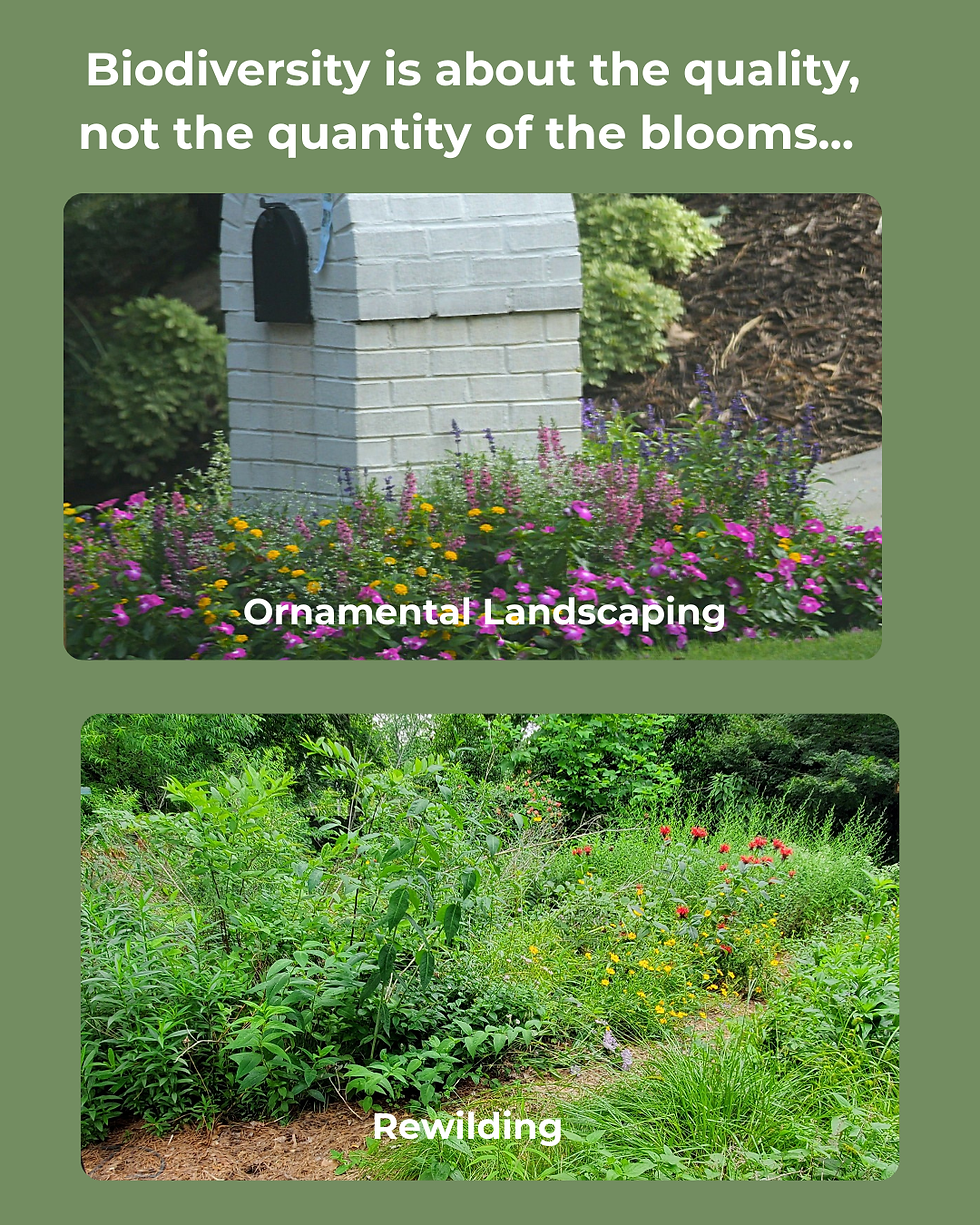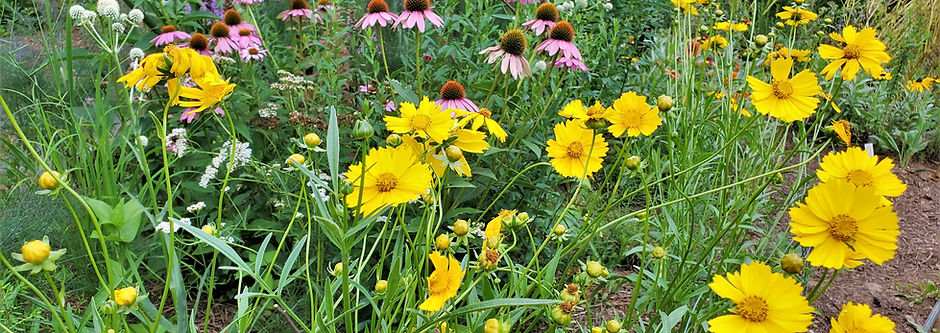Rewilding for a Greener Yard
- ljmarkson

- Aug 20
- 7 min read
A friend told me her family noticed that she once gardened for color and now her rewilded garden is mostly green. This observation is not without merit and highlights the different priorities between ornamental gardening from a horticultural perspective and ecologically aligned gardening focused on function.

I also once gardened to add as much color into my yard as possible. I labored over flower color and form and tried to recreate the same dreamy English cottage garden I saw in the gardening magazines and bulb catalogues I pored over. It was an impossible look to achieve the way I wanted because I live in a completely different climate than the English countryside. This kind of gardening was 100% about me and the aesthetic I wanted. It had nothing to do with where I lived or the wildlife that might use my yard to live and raise their young - wildlife meaning all the living things in an ecosystem.

For wildlife support I didn’t think much beyond naively adding problematic butterfly bushes for butterflies or pretty, exotic flowers for “pollinators”. The idea of using native plants did not enter my consciousness.

When I started transitioning to native plants to increase biodiversity and help the insect and bird decline, I was still gardening the same way I always did. I grouped the plants for color and I arranged them like I would a traditional garden, only I starting using native plants instead of non-native ones. Most of the plants were cultivars because there was a wider variety of color choices. I was also focused on color and used non-native annuals as fillers because they bloomed all season.

I started following the "plant this, not that" suggestions without considering the growing conditions or ecoregion they belong in or the habitat support value of native plants. It was disappointing because some plants that weren’t even close to being the right plant in the right place died. I was still thinking of plants as possessions: collecting the ones that pleased me and plunking them down in my yard like they were interchangeable. As I obsessively added every native plant I could, I didn't stop to think about why. I was keeping track of how many different native plants I had as if it was some sort of competition to have the largest variety. I even fell into the same search for the unique that is the cornerstone of ornamental gardening - and wanted the hard to find and unusual native plants.

When I learned what’s necessary to support a healthy ecosystem, and all about nature friendly concepts such as native plant communities, host plants, and living mulch, I stopped the crazy making of maintaining my yard to look the same every year. I started to relax, slow down, and observe what was going on in my yard. I let the plants tell me where they wanted to grow. Some flopped over reaching for the sun, and their seeds fell in the sunnier spot to come up the next year in a more ideal place. Some sent runners to shadier, sheltered spots where they could thrive. I let more plants meander and just edited them out of spaces we needed to walk or use in some way. I added plants for what they might do in my yard such as attracting a specialist bee or hosting a large number of butterflies and moths, not because I liked their flowers. I left the leaves where they fell (except on hardscapes) and the stems standing all year.
I stopped fixating on how my yard looks and focused on how it functions. Last year when it was hot and dry for an extended time, many plants didn’t grow very tall and went into early dormancy. This is how they adapted to the weather. Most survived, but the landscape looked rough. This year we’ve had so much rain that it really brought out the wild in rewilding! It’s liberating to embrace the chaos and all the life this year’s lush yard is supporting. When the growing season is over, I will regroup, rethink choices made and change anything that didn’t work well such as misplaced plants.
Neighbors have commented that my yard looks different every year which is what happens in a natural landscape. This is because a living landscape is always in motions and not static. The gardening tradition of mulched beds with blooming seasonal annual bedding plants is not only a dated and tired look but does little to support wildlife.

My yard looks nothing like I thought it would – it’s more vibrant and dynamic that I could have ever imagined – and messier! Nature is not neat and tidy – this random beauty is what draws us to admire natural areas. My dreamy but orderly cottage garden required immense inputs from me like watering all season long. I followed the gardening rules that came with the exhausting task of trying to control nature: managing the bad bugs like aphids and scary bugs like wasps; attracting the good bugs like swallowtail caterpillars and butterflies; deterring pesky wildlife like chipmunks making holes in my garden or squirrels burying nuts in my seasonal flowerpots; and trying to keep everything as picture perfect as possible.

As I learned about ecologically aligned gardening my perspective irrevocably shifted and the way I talked about wildlife changed from negative to protective. It turns out the more insects there are on host plants the better butterfly caterpillars do; wasps, beetles, and flies are important pollinators; wasps and flying pollinators are too busy pollinating or nesting to spend an ounce of energy bothering me; cute little chipmunks making holes are a non-issue in a rewilded yard (The Humane Gardener does a wonderful job defending chipmunks and explaining their role in the ecosystem); and endlessly fascinating squirrels belong in my urban yard and don't cause any harm when they bury nuts in my prairie inspired patio planters.

My welcome mat is now out for wildlife and my yard is filled with birds foraging, seeking shelter or cover, nesting, and raising their young; an abundance of diverse insects; and at night, my trail camera shows me the possums, raccoons, foxes, and other night creatures that pass through my yard.
Oh, and most of the time my yard is more green than colorful. There are flowering plants throughout the growing season, but the look is wilder and more random – like you’d see in a prairie at the edge of the woods. It’s dreamy in a messier and more natural way than the controlled cottage garden I once aspired to – and its filled with unexpected natural delights like an uncommon migrating bird visiting a bird bath or a fledgling being fed by an attentive parent. Every square foot of the yard is supporting wildlife habitat, even where there aren’t flowers. In the fall I might catch site of a queen bumblebee looking for a place to overwinter or a moth cocoon that looks like a leaf on the ground.
In a world where wildlife is disappearing at a terrifying pace, my tiny sanctuary offers hope that we can make an impact by supporting natural processes where we live. The beauty is not in drifts of bright and colorful flowers, but in the life my little green yard supports.

Note: There are no affiliate links in this blog. The highlighted text throughout the post might be references, details, explanations, worthy organizations or businesses, or examples that I think might be helpful.


.jpg)
